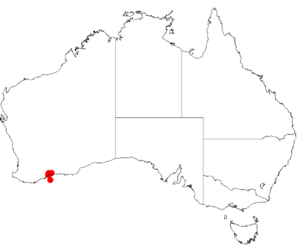East Barrens wattle facts for kids
Quick facts for kids East Barrens wattle |
|
|---|---|
| Conservation status | |
| Scientific classification | |
| Genus: |
Acacia
|
| Species: |
argutifolia
|
 |
|
| Occurrence data from AVH | |
The Acacia argutifolia, often called the East Barrens wattle, is a type of shrub. It belongs to a large group of plants known as Acacias. These plants are famous for their beautiful yellow flowers.
What it Looks Like
This shrub is usually low and spreads out. It has many branches that grow in a tangled way. It typically grows to be about 0.2 to 0.7 metres (1 to 2 ft) tall.
The East Barrens wattle blooms from July to December. It produces bright yellow flowers. Its leaves are not typical leaves; they are actually flattened leaf stems called phyllodes. These phyllodes are sharp and usually stick out. They can be straight or slightly curved. Each one is shaped like a triangle and is about 6 to 13 millimetres (0.24 to 0.51 in) long. They are also about 1 mm (0.04 in) wide.
The small branches of the plant have tiny hairs. They also have small leaf-like parts called stipules, which are about 1.5 to 2 mm (0.06 to 0.08 in) long. The flowers grow in simple groups, with one group under each phyllode. These flower stalks, called peduncles, are about 5 to 7 mm (0.20 to 0.28 in) long. The flower heads are round, like small balls. Each head has about 23 to 25 flowers that are pale yellow or cream colored.
After the flowers, the plant grows seed pods. These pods are flat on both sides and slightly squeezed between each seed. They are about 4 cm (1.57 in) long and 2 to 4 mm (0.08 to 0.16 in) wide. The pods are reddish-brown to dark brown. This shrub looks a lot like another plant called Acacia simulans.
Where it Grows
The East Barrens wattle grows in a small area of Western Australia. You can find it in the Fitzgerald River National Park, which is in the Great Southern region.
It prefers to grow in shallow sand that sits over a type of rock called quartzite. It lives among other plants in low, open areas. These areas can be heathlands, shrublands, or mallee communities. Mallee is a type of bushland where many plants have multiple stems growing from an underground root.
How it Was Named
The Acacia argutifolia was first officially described in 1976. A scientist named Bruce Maslin, who studies plants (a botanist), gave it its formal name. He wrote about it in a scientific paper called Studies in the genus Acacia (Mimosaceae) - Miscellaneous new phyllodinous species. This paper was published in a journal called Nuytsia.
For a while, it also had another name, Racosperma argutifolium. This name was given by another botanist, Leslie Pedley, in 2003. However, Acacia argutifolia is the name most commonly used today.


